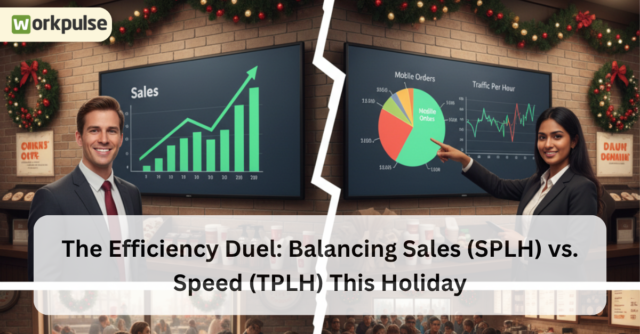As a multi-unit operator in 2025, you’re navigating the most complex environment in retail history. The convergence of persistent supply chain volatility, a transformed labor market, and hyper-personalized competition has squeezed margins to a knife’s edge. A recent forecast from the National Restaurant Association projects that food costs will continue to outpace menu price inflation, putting an additional 3-4% pressure on gross profits this year alone. This isn’t a temporary trend; it’s the new economic reality.
In this climate, your back office is no longer just an administrative function; it is your business’s central nervous system. An outdated, manual system—a patchwork of spreadsheets, paper invoices, and disconnected software—doesn’t just create frustration. It actively erodes profit, burns out your most valuable employees, and leaves your entire operation strategically vulnerable.
If you’re still relying on these legacy methods, you aren’t just falling behind; you are likely bleeding cash in ways that are nearly impossible to track. Here are the three critical, data-backed costs of an outdated back office and the actionable path forward to build a more resilient and profitable enterprise.
1. The Cost of Delayed Decisions: Profit Erosion in Real-Time
In the past, weekly or even monthly financial reporting was the standard. In 2025, it’s a recipe for disaster. With global supply chains causing local-level volatility, commodity prices for essentials like cooking oil, flour, and protein can shift over 5% in a single week. A seven-day delay in identifying and reacting to a cost increase is no longer a minor accounting issue; it’s a direct and significant profit leak.
The Real-World Impact: A Forensic Look at a “Silent” Loss Let’s deconstruct this. Consider a 20-unit franchise that uses 50 gallons of cooking oil per location per week.
- Initial Cost: $40/gallon
- Supplier Price Increase: 8% (an increase of $3.20/gallon)
- The Delay: Your system relies on manual invoice entry at the end of the week. For seven days, you are selling products based on the old cost, completely unaware of the margin erosion.
- The Calculation: 20 locations x 50 gallons/location x $3.20 price increase = $3,200 in pure, uncaptured cost that has vanished from your bottom line in a single week. By the time your accountant flags it, that money is gone forever. This isn’t a “cost of doing business”—it’s a direct tax on inefficiency.
The 2025 Pain Point: The Death of Static Reporting The fundamental flaw of old systems is that they are reactive. They provide a historical record of what has already been lost. A modern Retail Management System (RMS) operates on a principle of proactive financial defense. It provides real-time variance alerts. The moment an electronic invoice is received from a supplier with a price that deviates from the expected cost, your dashboard flags it.
This transforms your strategy from historical review to immediate, profit-saving action. You can instantly:
- Assess the Impact: Understand the immediate effect on the margins of your highest-selling items.
- Model Adjustments: Test a small menu price increase to offset the new cost.
- Negotiate Smarter: Use the real-time data to have an informed conversation with your supplier about the unexpected increase. This is the shift from being a victim of market volatility to actively managing it.
2. The Cost of Employee Burnout: The $15,000 Manager and the Culture of Frustration
The labor market of 2025 is defined by a new employee value proposition. Your team, especially your store managers, has an extremely low tolerance for “frustration work”—tasks that feel meaningless, repetitive, and detract from their core responsibilities of leading people and serving customers. According to a 2025 Gallup study on workplace engagement, a leading driver of employee turnover in the service industry is the feeling of being “bogged down by inefficient processes that prevent me from doing my job well.”
The Real-World Impact: The True Price of Inefficiency A store manager spending 10-15 hours per week on manual administrative tasks is a massive hidden labor cost. But the true expense emerges when they quit. The Center for Hospitality Research at Cornell estimates the total cost to recruit, hire, and train a replacement for a single QSR manager is now upwards of $15,000. For an organization with a 25% manager turnover rate across 20 locations, that translates to $75,000 in direct replacement costs annually, not including the immeasurable loss of morale and operational consistency.
The 2025 Pain Point: The War for Talent is Fought with Technology Your best competitor isn’t just offering higher pay; they’re offering a better, smarter work experience. Imagine the difference for a potential new hire:
- Company A (Old System): “You’ll need to collect the paper invoices, key them into this spreadsheet, manually balance the cash drawer, and call other stores if you need to transfer inventory.”
- Company B (Modern RMS): “Our system automatically imports invoices. You’ll use this tablet to scan inventory in minutes, and cash reconciliation is a guided, two-minute process on your phone.”
An investment in a modern RMS is a direct investment in your people and your employer brand. It eliminates the frustrating tasks that cause burnout. It frees your managers to do what they were hired for: to coach their team, interact with guests, solve creative problems, and grow the business. It tells your best people that their time is valuable.
3. The Cost of Data Silos: Strategic Irrelevance in the Age of AI
By 2025, the use of predictive analytics and AI in the retail and restaurant sector has grown by over 200% in just three years. Your most agile competitors are leveraging AI to forecast demand based on local events, weather patterns, and historical sales data to optimize labor schedules and inventory orders. They are not just managing their business; they are predicting it.
The Real-World Impact: Flying Blind with an Incomplete Map If your sales data is in your POS, your inventory data is in Excel, and your labor data is with a third-party scheduler, you have no chance of competing on this level. These “data silos” make it impossible to answer even the most basic strategic questions, let alone leverage advanced analytics. You cannot accurately answer:
- “How did last week’s 10% increase in beverage sales impact our paper cup and lid usage, and what is the true margin of that promotion?”
- “Which of our store managers is best at scheduling labor to maximize sales during peak hours, and what can the others learn from them?”
- “Which low-volume menu items are becoming completely unprofitable due to rising ingredient costs and should be discontinued?”
The 2025 Pain Point: You Can’t Use AI on Data You Don’t Have The future of retail decision-making is predictive. A unified RMS that integrates sales, inventory, and labor data doesn’t just give you clear reports; it creates the clean, structured, centralized dataset required to power future AI tools. It prepares you to answer questions that are impossible with siloed data. It is the foundational step to move from asking “What happened?” to asking “What will happen next, and what is the best decision we can make now?”
Without a centralized data platform, you are not just blind to the nuanced realities of your own business—you are strategically irrelevant in a market that is rapidly accelerating. Moving to a unified RMS is the essential step to ensuring your business is not only profitable today but also intelligent and competitive for years to come.




